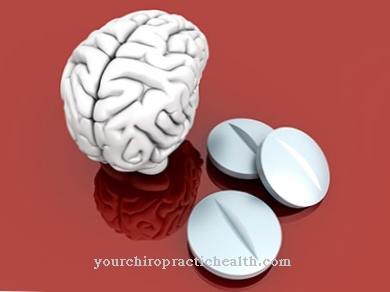Of the ergotism is poisoning by ergot alkaloids such as ergotamine or ergometrine, which occur in ergot fungi and are now used as drugs. In the foreground of the symptoms are massive circulatory disorders with the death of arms or legs, which can lead to death.
What is ergotism?

© Christoph Burgstedt - stock.adobe.com
Ergotism actually belongs to the category of "medical history": as a poisoning after the accidental consumption of ergot alkaloids with the grain, this disease ravaged thousands of unsuspecting farmers in the Middle Ages. Nowadays, however, ergotamine is still used in drugs for migraines or Parkinson's, so that here too, in rare cases of overdosing, ergot-like side effects can occur.
causes
Ergot alkaloids are produced by the fungus Claviceps purpurae, which mainly affects rye. The mushrooms sit as small crumbs on the plants and were therefore often overlooked during harvest in the Middle Ages.
This resulted in repeated epidemic poisoning, which killed thousands of people. Since the Antonite Order in particular had made it its mission to treat these epidemics in the Middle Ages, the disease was also called "Antonius Fire".
Ergotamine unfolds its effect in the human organism, once it has entered the bloodstream, primarily at the alpha receptors of the blood vessels: Here the ergotamine molecules cause a massive narrowing of the blood vessels, which means that large areas of the downstream tissue are no longer adequately supplied Blood can be supplied. The problem is then the same as with a heart attack or arterial thrombosis in the leg: tissue is no longer supplied with oxygen and dies within a short time with enormous pain.
Even though rye is grown nowadays while avoiding ergot infestation, the pharmacological effect of the alkaloids is still important today: The vasoconstricting effect of ergotamine can be used for migraine prophylaxis, for example, if one assumes that the pressure in the head as the cranial blood flow decreases something subsides.
Although this therapy is no longer standard, it can be successful in individual cases. Ergot alkaloids also play a role in the treatment of Parkinson's disease, and theoretically they can also be used when blood pressure is too low. Poisoning from nature also occurs from time to time. In all these cases the clinical picture of ergotism can occur.
Symptoms, ailments & signs
The symptoms of ergotism can be very diverse and do not always point directly to the disease. For this reason, the disease is often diagnosed and treated relatively late. Those affected generally suffer from a narrowing of the vessels, which is why less blood can be transported in the same time.
This leads to a low pulse and disorders of the blood circulation. As a result, those affected also suffer from permanent exhaustion and tiredness, although these complaints cannot be compensated with the help of sleep. Furthermore, ergotism can also lead to sensory disorders or even paralysis.
The paralysis itself usually only occurs temporarily and disappears again. The daily routine of the patient is clearly negatively influenced and made more difficult by the disturbances in sensitivity. Some people affected are therefore dependent on the help of other people in their everyday lives.
Furthermore, ergotism can also lead to vomiting or diarrhea and is often associated with various complaints in the stomach or intestines. In some cases, the disease negatively affects the patient's psyche and leads to delusions. If left untreated, it can lead to a heart attack, in which the affected person can die.
Diagnosis & course
The clinical picture of ergotism is mainly characterized by the functional vascular occlusions: Circulatory disorders occur throughout the body, which are particularly noticeable in the heart, kidneys and limbs.
Initially there is a tingling sensation and numbness in the hands and feet, and then there may be signs of paralysis. If the oxygen deficiency progresses, toes or fingers die painfully and turn black, the doctor then speaks of gangrene. General symptoms such as headache, nausea, ringing in the ears, diarrhea and delusions are added.
In addition to the possible massive heart attack, which can quickly result in cardiac death, and acute kidney failure, death can also result from respiratory paralysis. The decisive factor for the diagnosis of ergot alkaloid poisoning is knowledge of the use of appropriate medication or the possibility of other intoxication. The clinical picture is often not clear, especially since ergotism is an absolute rarity in today's clinics.
An ultrasound examination of the blood vessels in the arms and legs can be carried out on the basis of diagnostic equipment. While this provides evidence of the circulatory disorder, it cannot explain its cause either.
Complications
In the worst case scenario, ergotism can lead to death. In most cases, however, headache and nausea appear as symptoms. These are accompanied by itching and vomiting. As a rule, an ordinary everyday life is no longer possible for the patient due to ergotism and the quality of life is restricted.
The poisoning often leads to hallucinations or seizures. These can be associated with severe pain and, in the worst case, lead to cardiac arrest. Without treatment, the patient's pulse becomes slower and slower. Unfortunately, ergotism is difficult to identify because the symptoms of the first stage are very similar to those of the flu or the common cold.
Only in the second stage do the fingers and face swell. The extremities become numb and cold, and there are strong twitches in the arms and legs. The ergotism leads to restrictions in hearing and speaking.
Treatment by the doctor takes place in most cases by stopping the drug. Charcoal and sodium sulfate are also given to relieve symptoms. Gastric lavage may be necessary to completely detoxify the body. This means that there are no further complaints if the ergotism is treated in good time. In severe cases, operations are necessary.
When should you go to the doctor?
A doctor should be consulted as soon as symptoms such as cramps or sharp pain develop. The convulsive disorder can show itself all over the body, with the focus area of the stomach. The pain occurs more and more in the chest area and, due to the intensity, makes you feel short of breath.
If nausea or vomiting occurs repeatedly, a doctor should be consulted. Headaches, general weakness or a drop in the usual level of performance should be examined and medically treated. If the symptoms occur immediately after eating, this is considered worrying. A doctor should be consulted as soon as possible.
If there is an unexplained itchiness on the skin, this should be examined medically. If there are open wounds, the risk of infection and blood poisoning increases. Consult a doctor in the event of pus formation, fever or general malaise. Ergotism is a rare disease these days, but should be thoroughly investigated and treated at the first sign.
If changes in behavior are noticed in the person concerned that occur suddenly and unexpectedly, a doctor's visit is necessary. If the symptoms occur after taking medication, they should be checked for their ingredients. Consultation with the attending physician is necessary.
Doctors & therapists in your area
Treatment & Therapy
In order to counteract the onset of ergotism, it is of crucial importance to stop taking the triggering medication. This alone should be enough to neutralize the vasoconstricting effect and to make sufficient oxygen available again to the starving tissues. If this alone is not enough or if it is already an emergency, active vasodilation can be achieved by infusing calcium antagonists, nitrates and prostaglandins.
Outlook & forecast
Ergotism patients can suffer further deterioration in their health without an immediate change in drug intake. The supply of tissues and organs is impaired by the intake of preparations containing the active ingredient ergotamine. The patient is threatened with paralysis, the death of the limbs and, in severe cases, the failure of various systems can lead to premature death.
Nowadays the disease ergotism is usually triggered by the administration of medicines to relieve a migraine or Parkinson's disease. All other causes have already been eliminated or are no longer vacant due to the evolutionary changes of the last centuries. The active ingredient ergotamine is still contained in some medical preparations today. Although newer therapies for migraine prophylaxis or for Parkinson's disease are normally used, drugs containing ergotamine may still be taken in exceptional cases.
For a good prognosis and a healing prospect, the active ingredient must be removed from the body as quickly as possible. Immediate discontinuation of the prescribed drugs is therefore essential. If the symptoms are not yet severe, the state of health is restored. If the patient is already suffering from irreversible damage by taking the preparations, stopping the medication prevents progress in the deterioration of health.
prevention
To prevent ergotism, it is of course important to carefully weigh up the benefits and risks when taking appropriate medication. For this reason, ergotamine has now become medically out of fashion as a migraine drug.
Agriculture has meanwhile developed various cultivation protocols and cleaning techniques in order to minimize the ergot infestation of the rye. There is no longer any risk of poisoning like in the Middle Ages when consuming this grain.
Aftercare
In the case of ergotism, the aftercare measures are very limited in most cases.As a rule, the person concerned is first dependent on the treatment of this poisoning so that there are no further complications or, in the worst case, death of the person concerned. The earlier the poisoning is recognized and treated, the better the further course will usually be.
Follow-up care is based on avoiding the triggering substance so that the ergotism cannot recur. The triggering medication should definitely be discontinued or replaced by other medication after consulting a doctor. In an emergency, however, ergotism should be treated in a hospital or by an emergency doctor.
Those affected are dependent on taking supplements to alleviate the symptoms. It is important to ensure that it is taken regularly and correctly, always consulting a doctor. Furthermore, the person concerned should definitely rest and take care of the body. Unnecessary loads or other strenuous and stressful activities should definitely be avoided. If the ergotism treatment is successful, the life expectancy of the affected person does not usually decrease.
You can do that yourself
In everyday life, it is important to watch out for food contamination before it is consumed. Ingested food should be adequately cleaned before it is fed raw to the organism. They must also be thoroughly cleaned before being processed for meals.
This is especially true for grain products. Consumption of freely growing grain should be avoided. If the symptoms occur immediately after taking medication, contact the doctor treating you immediately. The further procedure must be discussed in consultation with the doctor.
If the intolerance of the ergot alkaloids additive is already known, its ingredients must be checked carefully before taking a medicinal preparation. Then the medication should be discussed with the doctor or the drug should be exchanged. If the first symptoms arise, the instructions of a doctor must be followed.
To improve your own well-being, it is advisable to take in sufficient fluids. In addition, the immune system should be supported by a diet rich in vitamins and fiber. Getting enough sleep and avoiding unnecessary stress are also beneficial.
In contaminated stables or grain stores, the consumption of food must be completely avoided. In case of doubt, the food stored there should be disposed of or examined for harmful substances in the laboratory.



.jpg)
.jpg)







.jpg)



.jpg)










.jpg)
